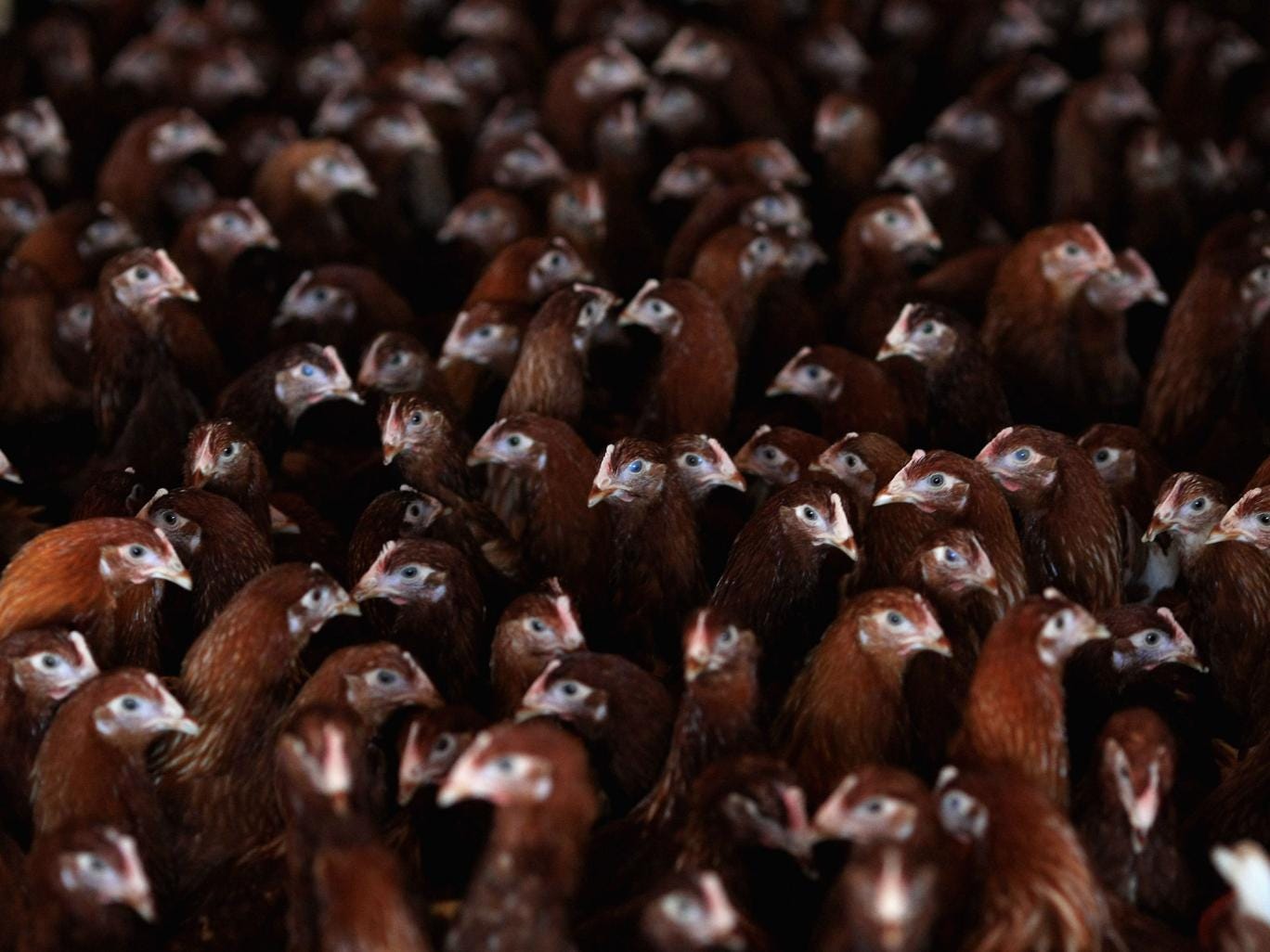
Antibiotics that were banned on US chicken farms a decade ago over links to the spread of potentially deadly bacteria in humans are being used in significantly increased quantities by the British poultry industry, an investigation has revealed.
Industry figures obtained by the Bureau of Investigative Journalism show that UK poultry producers raised their use of a class of antibiotics known as fluoroquinolones by 59 per cent in the latest 12-month reporting period – despite evidence that they could be fuelling drug resistant forms of dangerous food poisoning illnesses in humans, including campylobacter, salmonella and E.coli.
The antibiotics are used on factory farms where chickens and other poultry are intensively reared in crowded conditions that can encourage the spread of disease.
But serious problems arise because the same class of drugs are also used in human medicine to treat people who suffer severe cases of foodborne infections.
Experts warn that their overuse in livestock farming has encouraged the bacteria behind these infections to evolve and become immune to the antibiotics’ effects.
That means consumers who contract the bugs – often from infected poultry meat – and subsequently develop complications may not respond to antibiotic treatment.
Professor Mike Catchpole, one of Europe’s leading infectious disease experts and the chief scientist at the European Centre for Disease Prevention and Control (ECDC), told the Bureau there was already evidence of an association between drug-resistant salmonella and “excess mortality” – and that patients seriously ill with resistant forms of campylobacter were at “greater risk of death or infections”.
It is for these reasons that fluoroquinolones have been banned in poultry production in the US, as well as Australia, Finland and Denmark.
Yet unpublished figures compiled by the British Poultry Council (BPC) – which represents about 90 per cent of the UK industry – show that its members have increased their use of the drugs, using 1.126 tonnes of fluoroquinolones in 2014 compared with 0.71 tonnes the previous year.
The increased use of the antibiotics – which is not illegal in the UK – indicates that at least 20 million more chickens were given a dose of the antibiotics in 2014. The Bureau’s revelations have prompted calls for fluoroquinolones to be immediately withdrawn from use in British poultry farms.
Coílín Nunan, a scientific adviser with the Alliance to Save Our Antibiotics, said the “shocking and alarming” 59 per cent rise was “likely to have real consequences for human health”.
He said: “The Government should ban all use of fluoroquinolones in poultry because we know resistance is transferring from chickens to humans. This is why the US banned fluoroquinolone use in poultry a decade ago.”
Labour’s shadow Environment Secretary, Kerry McCarthy, said: “Experts have long been warning that widespread antibiotic use in farming risks undermining their effectiveness in human medicine. These figures show that more needs to be done to reduce their use.”
Antibiotics are widely used in livestock production to prevent and treat illnesses. While farmers say their use is vital for animal welfare, critics say the drugs are often used to compensate for dirty, overcrowded conditions that can encourage the spread of disease.
The US Food and Drug Administration outlawed the use of fluoroquinolones in chicken farming in 2005 after resistance to the drugs was found to be developing in campylobacter samples in poultry flocks. Campaigners have for several years been calling on the UK authorities to follow suit.
They are also concerned about a lack of transparency about the level of usage on Britain’s farms. Although farmers are required to keep records of antibiotics administered to livestock, and vets should maintain details of antibiotic prescriptions, this data is not currently collated by the industry regulator, the Veterinary Medicines Directorate (VMD).
An agency in the Department for Environment, Food and Rural Affairs, the VMD publishes overall sales data for veterinary antibiotics annually but not details of antibiotic usage. This means health officials have little idea why – and in what quantities – the drugs are being used on individual farms.
In a statement to the Bureau, the VMD acknowledged that current data collection of antibiotic use on farms could be improved, saying it was “a priority area of the VMD’s work on antimicrobial resistance”.
A spokesperson said: “The overuse of antibiotics in farming is a major issue worldwide, and we are working closely with countries across the world to monitor it so that we can take action.”
There is particular concern about antibiotic resistant cases of campylobacter, Britain’s most common type of food poisoning. The bug infects up to 300,000 people, puts 1,000 in hospital and kills about 100 each year. Contaminated poultry is blamed for four in five cases.
A major ECDC study that analysed human campylobacter cases in a number of EU countries from 2013 found that 60 per cent were resistant to ciprofloxacin. It also said 62 per cent of poultry birds infected with the bug were found to be carrying the resistant strain.
The ECDC’s Professor Catchpole said: “There are lines of evidence that strongly suggest that the use of antimicrobials [which include antibiotics] in food-producing animals not only results in the occurrence of resistant bacteria in the exposed food-producing animals but also in humans.”
Despite cautioning that most food poisoning cases were “self-limiting”, with victims recovering naturally without the need for antibiotic treatment, he said that in some cases – primarily in patients with compromised immune systems – the infections “can cause systemic disease with possibly fatal outcomes”.
“Drug-resistant bacteria have been associated with excess mortality for salmonella and with greater risk of death or invasive infections for campylobacter,” he said.
“Treating infections due to resistant bacteria is a challenge: antimicrobials commonly used are no longer effective and doctors have to choose other antimicrobials. This may delay getting the right treatment to patients and may result in complications. Also, a patient may need more care as well as alternative and more expensive antimicrobials, which may have more severe side-effects.”
The British Poultry Council said that it had taken a leading role in reducing the use of antibiotics, with a particular focus on those drugs of critical importance for human medicine. A spokeswoman said: “The BPC and its members recognise the importance of fluoroquinolones for human medicine, and we will continue to work with our members to significantly reduce the usage of all classes of antibiotics including the fluoroquinolones.”
Additional reporting by Jack Serle
The drugs don’t work: resistant bacteria
Fluoroquinolone antibiotics were developed in the 1970s and first used in human medicine in the 1980s.
The drugs are used for treating human food poisoning illnesses such as campylobacter, salmonella and Ecoli.
The World Health Organisation (WHO) has classified fluoroquinolones as being “critically important” to human healthcare, and said the use of the substances on livestock farms should be curtailed.
This is because of growing global evidence that the overuse of the antibiotics on factory farms is fuelling the development of drug resistant forms of food poisoning bugs.
Concerns over the links between fluoroquinolone use on farms and antibiotic resistant bacteria were raised as far back as 1998, when a House of Lords committee urged the poultry industry to reduce its use of fluoroquinolones.







